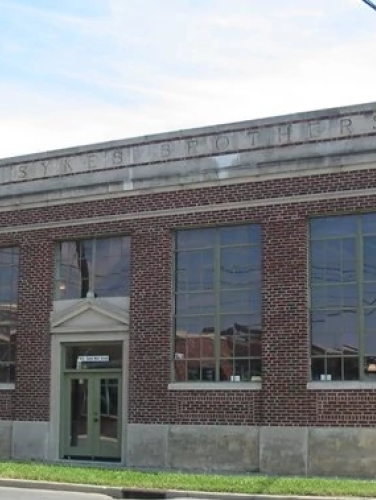
Joseph Sykes Brothers Building
(ca. 1926)
The Joseph Sykes Brothers Company Building is a rare reminder of uptown Charlotte’s industrial and manufacturing history.
1445 S Mint St, Charlotte, NC 28203
Located within a warehouse and industrial district south of center city Charlotte, the Joseph Sykes Brothers Company Building represents the diverse operations that made the city the leading manufacturing and distribution center of the Carolinas and a flourishing New South city by the early twentieth century. Cotton mills factored prominently in that growth, as more than 300 cotton mills were constructed within a 100-mile radius of Charlotte by World War I. But Charlotte and Mecklenburg County also prospered as the result of an extensive railroad system, expanding work force, and plentiful and inexpensive electric power, making the area attractive to a variety of manufacturers and regional distributors. By the 1920s, Charlotte’s 141 factories manufactured eighty-one different products, boasting a 150-mile trading radius containing more than 4.5 million consumers. By the end of World War II, in addition to its predominant textile industry, the county’s 243 other industrial plants manufactured products valued at an estimated $50 million per year.
Property Quick Links
The Joseph Sykes Brothers Company was one of the textile-ancillary manufacturers drawn by Charlotte’s dynamic local economy. An international company headquartered in Huddersfield, England, Sykes Brothers produced steel wire card clothing, a sturdy specialized fabric with embedded wire teeth used to align cotton fiber for easier spinning. In 1899, the company opened its first U.S. plant in Charlotte on South Tryon Street, following the migration of the textile industry from England – the dominant textile producer between 1750 and 1850 – to the United States. With the rapid development of a Southern textile industry after the Civil War, suppliers from both New England and Britain set up operations in Charlotte and other Southern textile centers in an effort to retain their client base. Without the support of an urban infrastructure that included manufacturers like Sykes Brothers to produce ancillary textile machinery components, as well as support businesses like engineering firms, financial institutions, and department stores, cotton mills could not have proliferated as quickly as they did in the Carolinas in the early twentieth century. In 1926, Sykes Brothers decided to consolidate its production and administrative operations into a new building on South Mint Street.
Sykes Brothers hired the South Carolina architectural and engineering firm of Lockwood, Green & Company to design its new building, and selected local construction firm of Blythe and Isenhour as its builder. Completed at an estimated cost of $35,000, the one-story building included a steel support system in anticipation of additional stories should business expansion demand more space. Those expansion plans were never implemented because, by WWII, downtown Charlotte was primarily a commercial and business center, leaving little of its old industrial fabric. South Mint Street attracted factories and warehousing facilities through the 1950s, but larger companies opted for less expensive real estate around Charlotte’s periphery. The opening of Interstate Highway 85 in the early 1960s reoriented much of the city’s industrial geography, leaving older industrial areas vulnerable to abandonment and demolition. Sykes Brothers continued operations at its South Mint Street location through the 1960s, but evolving textile technology and foreign relocation of many textile firms led to sharp declines in the company’s business, finally ending its seventy years of Charlotte-based operations in the early 1970s. The building has since been adaptively reused for commercial office space.

